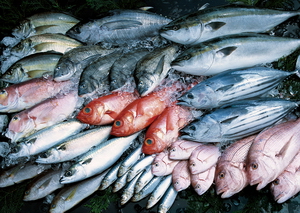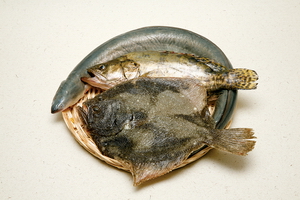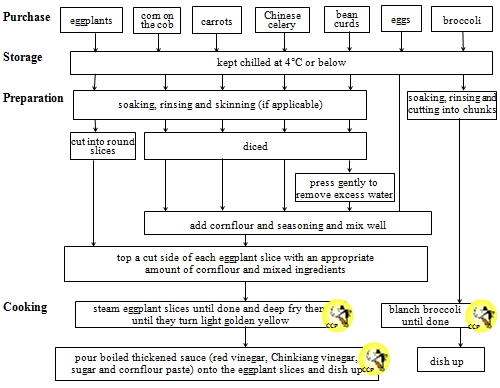
Feature Article
Risks of Eating Raw Seafood
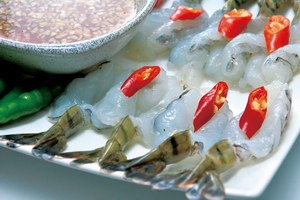
Hong Kong people are fond of fresh flavours of food. Raw foods, notably raw oysters and sashimi, are especially popular. In Korean and Thai cuisines, so well received in Hong Kong in recent years, such dishes like the well-known Ganjang-gejang (raw crabs marinated in soy sauce) and shrimp sashimi are actually seafood served raw or half cooked. While savouring the fresh taste, do we realise the potential risks of eating raw seafood? Seafood may also be contaminated by pathogens. How much do you know about pathogens?
Parasites
Parasites are organisms that live on or in a host so as to derive benefits from or at the expense of their hosts. They can be found in various kinds of food, including meat and seafood. The parasites present in seafood include Paragonimus westermani (PW), an infectio u s lung fluke, and Clonorchis sinensis (CS) (also known as the Chinese liver fluke) .
Freshwater crabs may be infected with PW due to contamination. When a person consumes raw or undercooked crabs carrying the lung fluke, the parasite may migrate from the intestines to the lungs and cause paragonimiasis. Initial symptoms of the disease include diarrhoea and abdominal pain, followed several days later by fever, chest pain, fatigue, and sometimes expectoration of blood. Lung flukes can even travel to the brain and cause symptoms of meningitis.
CS can be found in freshwater fish, mainly cyprinid fish like grass carp and big head carp. If we eat undercooked CS-infested freshwater fish, we will also be affected. Light infections will produce mild or no symptoms, but large numbers of such parasites can cause prolonged intense infections, resulting in loss of appetite, diarrhoea and fever. CS can also bring about bile duct obstruction and cirrhosis. In severe cases, the parasite can cause chronic jaundice and subsequently a higher occurrence rate of cholangiocarcinoma.
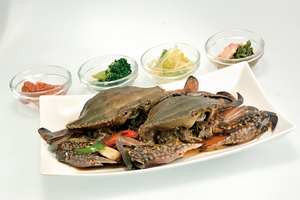
Bacteria
Apart from parasites, what other biohazards are present in seafood? Bacteria are widely known as major vectors of foodborne diseases. Among them, Vibrio parahaemolyticus (VP) is the most common pathogen found in seafood. VP occurs naturally in coastal and estuarine environments in tropical to temperate zones. It may be carried by aquatic organisms like shrimps, mussels and oysters in these areas and can grow rapidly under favourable conditions. Consumption of VP-contaminated and undercooked seafood can put us at risk of VP infection. The general signs include diarrhoea, vomiting, mild fever and abdominal pain. The patients will usually recover in a few days. Severe illness is rare but the symptoms occur more commonly in children, the elderly and persons with weakened immune systems.
Vibrio cholera (VC) is another pathogen found in seafood. Consumption of bivalve mollusk, crustacean and fish contaminated with VC may cause cholera with symptoms like severe diarrhoea and vomiting. Infected persons may die of dehydration if not treated in time.
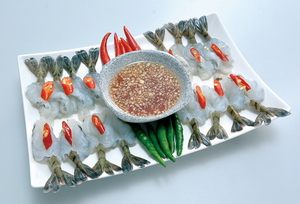
Viruses
Virus is also a biohazard associated with the consumption of raw seafood. Viruses are very simple and small organisms. They can be present in contaminated food and water supplies, or shellfish harvested from sewage-contaminated waters. The infective dose of most viruses is extremely small. In Hong Kong, norovirus (NV) is a prevalent foodborne virus that can be found in sewage. Shellfish in sewage-polluted areas or surrounding waters are very likely contaminated by NV. NV can lead to gastrointestinal diseases. The common symptoms include nausea, vomiting, diarrhoea and abdominal cramps.
In Hong Kong, raw oysters are considered the major cause of NV-related food poisoning incidents. NV binds to oyster tissue within the gut and can concentrate up to 99 times compared with the surrounding waters. It is difficult to remove NV from oysters by cleansing. Depuration is likewise ineffective.
From the above, we should be able to gain an understanding of the biological hazards of consuming raw seafood. The public should take note of the risks of eating raw seafood accordingly . As foods for raw consumption are not cooked at a high temperature, we must exercise due care during the whole process of food handling, including the purchase of raw materials, the cleanliness of utensils and personal sanitation, in order to ensure food safety and hygiene, and minimise the risk of contracting foodborne diseases.
Key points to note:
- Marinating live crabs with ingredients such as wine, vinegar, soy sauce, garlic and / or chilli cannot eliminate their parasites. Cooking crabs thoroughly is the only way to prevent diseases caused by parasites.
- The sale of Chinese Yu Sang (raw freshwater fish) is banned in Hong Kong. Do not sell any raw or undercooked freshwater fish. Wine, vinegar, wasabi, mustard and spices cannot kill CS and the other parasites of freshwater fish. When raw freshwater fish are used for hotpots or congees, avoid cutting the fish into thick slices and check that the flesh is thoroughly cooked.
- Both Thai-style shrimp sashimi and Japanese - style seafood sashimi have not been thoroughly cook ed at a high temperature . T he ir foodborne pathogens have not been removed. When purchasing sashimi as raw materials, make sure that the food is intact, hygienic, good in quality and supplied from reliable suppliers with a sound reputation.
- NV is acid-resistant. Eating contaminated oysters with lemon juice, vinegar or alcohol cannot prevent NV infection.
Health Benefits of Eating Fish
Fish is commonly consumed by the locals. However, according to the results of a risk assessment study on non-dioxin-like polychlorinated biphenyls (NDL-PCBs) released earlier by the Centre for Food Safety (CFS), this group of chemical contaminants is more likely to be found in fish. The results of the study have sparked public concern about eating fish, especially salmon. Does eating fish bring more good than harm, or is it the other way round?
Fish is not only an excellent source of high quality proteins and omega-3 fatty acids , it also contains various kinds of nutrients like iodine, selenium, calcium, iron and vitamins A and D. Omega-3 fatty acids such as DHA and EPA are found in every kind of fish, and are especially high in fatty fish (e.g. salmon and yellow croaker). Omega-3 fatty acids help lower the risk of coronary heart disease and stroke, and are good for foetal neurological development. While calcium and vitamin D are important for the development of healthy teeth and bones, iodine is needed for the production of thyroid hormones. D eficiency of iodine in the diet may lead to goitre and arrested growth.
Nevertheless, in eating fish, we are inevitably exposed to contaminants like dioxins, dioxin-like polychlorinated biphenyls (PCBs) and mercury.
Dioxins and PCBs are persistent organic pollutants. They have toxic effects on a number of human systems, including endocrine and immune systems and the developing nervous system, and may cause cancer s . Nevertheless, previous studies conducted by CFS have confirmed that it is unlikely for the local population to experience, through food consumption, undesirable health effects of dioxins and PCBs, including NDL-PCBs. In addition, many overseas studies have reported a reduction in the level of these contaminants in fish over the years.
Another type of metallic contaminant which may enter the human body through the consumption of fish is mercury. T he organic form of mercury is m ethylmercury , which can adversely affect the nervous system in the developing foetus. Studies have shown that some predatory fish species may contain high levels of methylmercury . They are therefore a concern for women of childbearing age. Besides, young children whose brains are still developing may be more susceptible than adults to the adverse effects of methylmercury, which include a reduction in i ntelligence quotient (IQ).
However, the level of mercury in fish varies according to the source of food for fish and the environment of their living waters. Generally speaking, smaller fish (below one catty), farmed fish, freshwater fish and non-predatory fish contain lower levels of methylmercury. Hence women of childbearing age and young children should have a moderate consumption of a variety of fish and avoid eating large predatory fish, such as tuna (especially the bigeye and bluefin species), alfonsino, shark, swordfish, marlin, orange roughy and king mackerel, in order to avoid excessive intake of methylmercury, which can be harmful to the developing nervous system.
According to the Food and Agriculture Organization and the World Health Organization, a comparison between the benefits of omega-3 fatty acids and the risks of methylmercury among women of childbearing age indicates that maternal fish consumption generally lowers the risk of suboptimal neurodevelopment in their offspring when compared with the offspring of women not eating fish. The European Food Safety Authority has also reported that seafood consumption during pregnancy is associated with better functional outcomes of neurodevelopment in children as compared with no consumption of seafood including fish.
In short, by maintaining a moderate intake of a variety of fish, we can strike a balance between the risks and the benefits of eating fish. As fish contain various nutrients needed for the growth and development of the human body, fish consumption is obviously more beneficial than harmful to our health . It is advisable to eat a variety of fish in moderate amounts a s part of a balanced and diverse diet. However, for pregnant women and young children, they are more susceptible to the adverse effects of mercury and should avoid the consumption of large predatory fish.
Monosodium Glutamate (MSG)
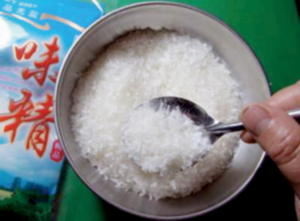
The pros and cons of using monosodium glutamate (MSG) are a subject of concern among consumers. Before discussion, let us first learn about the ingredients, characteristics, application and safety of MSG.
In the early 20th century, a Japanese chemistry professor discovered that glutamic acid extracted from seaweed gave a taste very different from sweetness, saltiness, sourness and bitterness. He named this distinctive taste "umami", meaning "meaty" or "savoury" in English. Glutamic acid either exists in bound form (i.e. bound to other amino acids as part of proteins) or in free form (i.e. not bound to other amino acids as part of proteins). Only the free form of glutamic acid can impart the "umami" taste to food with a flavour enhancing effect.
MSG is the sodium salt of glutamic acid, which is one of the most abundant amino acids found in nature and an important component of proteins. Various salts of glutamic acid including MSG, as well as the ionic form of glutamic acid, are all known as glutamic acid. Actually, the production of glutamic acid takes place in our body. This substance, for example, can be found naturally in breastmilk. Food ingredients like hydrolysed protein, autolysed yeast, yeast extract, soy extract, etc. also contain high levels of glutamic acid. Glutamic acid in MSG is chemically indistinguishable from the same naturally present in food. Our body metabolises glutamic acid from these sources in exactly the same way.
Apart from MSG, glutamic acid and a variety of its salts can also be used as flavor enhancers to enhance or improve tastes and / or flavours of food. These food additives are labelled as glutamic acid (620), MSG (621), monopotassium glutamate (622), calcium glutamate (623), monoammonium glutamate (624) and magnesium glutamate (625) on the food labels. MSG and other flavour enhancers are usually added to soups, stews, stocks, meat-based sauces, seasoning mixes and snacks.
Some people may consider themselves sensitive to MSG or develop mild and short-term symptoms (the symptom complex of headache, numbness / tingling in back of neck, flushing, muscle tightness and generalised weakness) after the consumption of MSG. Nevertheless, a number of international and national food safety authorities have evaluated the safety of MSG on multiple occasions and concluded that available evidence fails to demonstrate a causal relationship between MSG consumption and the development of this symptom complex. Considering the usual amount of MSG we add to food and the usual dietary intake of glutamic acid from ingested protein, the consumption of MSG is generally recognised as safe.
Salt is the major contributor to sodium intake. Excessive sodium intake is associated with an increased risk of hypertension, stroke and cardiovascular diseases. The amount of salt added to food should therefore be controlled. To reduce sodium consumption, a feasible way is to substitute MSG for some of the salt in food.
Advice to the Trade
- To reformulate food products by using less salt and sodium-containing seasonings.
- In using MSG for salt reduction, follow the Good Manufacturing Practice to limit the amount of MSG necessary to the lowest level for enhancing food flavours.
- To comply with local legislative requirements by properly labelling food additives including MSG.
News on New Dishes
Eggplant Stuffed with Assorted Vegetables and Bean Curd
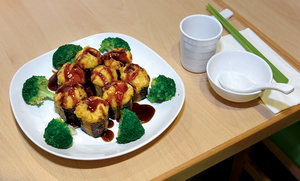
When talking about eggplants, what are the dishes that cross your mind? Stewed eggplant and shredded salty fish in claypot? Eggplant, bell pepper and fried bean curd stuffed with min ceddace? Eggplant is really a versatile ingredient. With a bit of creativity and imagination, we can use eggplant to produce a wide variety of delicious dishes. In this issue, we have invited the chef team of "Happy Veggies" , a signatory of the Food Safety Charter and a social enterprise providing employment opportunities for people with hearing impairment, to demonstrate the preparation of a colourful, aromatic and tasty vegetarian dish with eggplant as the main ingredient, namely " Eggplant Stuffed with Assorted Vegetables and Bean Curd ".
| Preparation Steps | Small Tips, Great Wisdom | |
|---|---|---|
Receiving 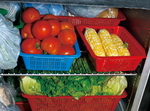 |
Purchase eggplants, bean curds, corn on the cob, carrots, Chinese celery and the other ingredients from approved and reliable sources. | Upon receipt of the ingredients, check carefully to ensure their freshness. Vegetables and bean curd should be chilled at 4ºC or below. |
Rinsing 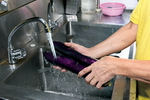 |
Rinse all ingredients thoroughly. | Rinsing the vegetables under a running tap or soaking them in water for an hour can effectively reduce the risk of pesticide exposure and remove surface impurities such as sand and mud. |
Cutting 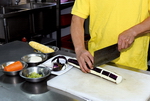 |
Partially skin the eggplant. Top and tail it, then cut it into round slices (about 2 inches long). Dice the other ingredients including carrots and Chinese celery, and remove corn kernels from the cob. | Diced ingredients can be fully cooked quickly, hence saving the cooking time. |
Mixing and Steaming 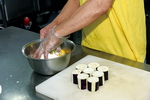  |
Press the bean curd gently to remove excess water. Add eggs, diced carrots, diced Chinese celery, corn kernels and a small amount of cornflour and seasoning. Mix well. Top a cut side of each eggplant slice with an appropriate amount of cornflour and mixed ingredients. Place the slices in a steam cabinet. Steam them for about 8 minutes until done. | Steaming the eggplant slices can shorten the time required for deep frying at a later stage, thus reducing the risk of formation of harmful substances during high-temperature cooking. |
Deep Frying  |
Deep fry the steamed eggplant slices in wok until they turn light golden yellow . Put them on a plate and set aside. Blanch the broccoli until done to garnish the dish. | Deep fry the eggplant slices until they turn light golden yellow, not dark brown. This can shorten the time of high-temperature cooking and prevent the formation of harmful substances. |
Saucing 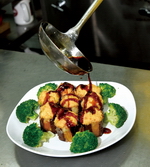 |
Add some water to wok. When the water is boiling, add an appropriate amount of red vinegar, Chinkiang vinegar, sugar and cornflour paste to thicken the sauce. Bring sauce to the boil until thickened and pour it onto the eggplant slices. Ready to serve. | Bring the seasoning sauce to the boil until thickened and pour it onto the eggplant slices. The food should be consumed immediately. |
Experience Sharing by Chef Team of "Happy Veggies"
To promote a healthy vegetarian and eco-friendly dining culture to the general public, Happy Veggies, a vegetarian restaurant, strictly adheres to the five major principles of "less oil", "less sugar", "less salt", "no monosodium glutamate" and "no processed ingredients" to preserve the original taste and flavour of food as far as possible. The restaurant orders ingredients from reputable suppliers and in limited quantities based on daily requirement to ensure fresh supply of ingredients every day. Moreover, the ingredients are stored at 4°C or below for later use, and dishes are made to order so that the food remains fresh and safe.
Eggplant absorbs oil readily like a sponge. To reduce the amount of oil absorbed by the eggplant slices and to improve their texture and mouthfeel, we should steam the slices until done before brisk deep frying them in boiling oil. This is the clue for deep frying the eggplant slices without making them greasy.
Press the bean curd gently to remove excess water. This can help prevent water from entering the eggplant slices to make them mushy.

The chef team of "Happy Veggies":
Messrs William NGAI (General Manager), CHEUNG Wai-leung (Executive Chef), LI Yiu-kong (Master Chef), WONG Chun-kit (Assistant Chef), LAU Wing-cheong and SIN Yin-sau (both Chef Assistants)
Food Safety Plan Corner
Eggplant Stuffed with Assorted Vegetables and Bean Curd
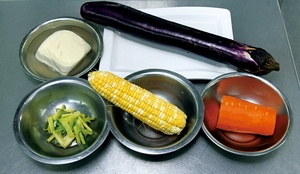
Ingredients:
Eggplants, corn on the cob, carrots, Chinese celery, bean curds, eggs and broccoli
Thickened Sauce:
Red vinegar, Chinkiang vinegar, sugar and cornflour
Steps:
- Take out the vegetables and bean curds that have been stored at 4°C or below.
- Soak the vegetables in water for an hour and rinse them thoroughly under running water.
- Partially skin the eggplant. Top and tail it, then cut it into round slices (about 2 inches long).
- Dice the ingredients including carrots and Chinese celery, and remove corn kernels from the cob.
- Press the bean curd gently to remove excess water. Add eggs, diced carrots, diced Chinese celery, corn kernels and a small amount of cornflour and seasoning. Mix well.
- Top a cut side of each eggplant slice with an appropriate amount of cornflour and mixed ingredients. Place the slices in a steam cabinet. Steam them (about 8 minutes) until done.
- Deep fry the steamed eggplant slices in wok until they turn light golden yellow . Put them on a plate and set aside. Blanch the broccoli until done to garnish the dish.
- Add some water to wok. When the water is boiling, add red vinegar, Chinkiang vinegar, sugar and cornflour paste to thicken the sauce. After bringing the thickened sauce to the boil, pour it onto the eggplant slices. Ready to serve.
Production Process
|
Critical Control Point ( CCP) It is a step or procedure in a food manufacture process at which control can be applied and, as a result, a food safety hazard can be prevented or eliminated. The Critical Control Points in the production of "Eggplant Stuffed with Assorted Vegetables and Bean Curd" are:
|
Briefing of Activities
Food Safety Seminar for Trade 2015

The Food Safety Seminar for Trade 2015 was successfully conducted at Lecture Hall , Hong Kong Science Museum on 15 September 2015. CFS hopes that it can serve as a platform for the food business and the Government to exchange information and views on major current food safety issues in Hong Kong.
At the beginning of the seminar, CFS representatives briefed the trade on the Food Safety Ordinance, the Pesticide Residues in Food Regulation and nutrition labelling and declaration of allergens of prepackaged food products , including their enforcement and compliance in Hong Kong. The next session, devoted to food safety promotion, comprised talks on " 5 Keys to Food Safety" , the Hazard Analysis and Critical Control Point (HACCP) System and " M easures to Reduce the Risk of Contamination of Listeria monocytogenes in R eady-to-eat F ood" . After lunch, CFS continued to discuss with the trade the food legislation recently implemented or proposed, including the regulation for and the proposed regulatory framework on formula products and foods intended for infants and young children, as well as the Imported Game, Meat, Poultry and Eggs Regulations. CFS further encouraged the trade to join "Hong Kong's Action on Salt and Sugar Reduction" and the "Reduce Salt, Sugar and Oil. We Do!" programme in providing safer and healthier food for customers. Dr Philip HO Yuk-yin , Consultant (Community Medicine) (Risk Assessment and Communication) of CFS, then concluded t he seminar by leading a panel discussion on how to prepare healthier food with less salt and sugar.
Please browse the CFS website ( www.cfs.gov.hk ) for the s eminar materials if you are interested .
Upcoming Activities
Trade Talk and Workshop on HACCP
CFS will organise the next annual Trade Talk and Workshop on HACCP in 2016 to promote to members of the food business proper ways of food handling , the adoption of the HACCP System and the application of the "Food Safety Plan" in food processing with a view to enhancing food safety. Some of the talks will focus on specific food items (e.g. Poon Choi, Siu Mei and Lo Mei) and provide in-depth briefings for the participants.
Food premises will receive invitation letters and enrolment forms on the dates, time and venues of the talks. Please browse the CFS website (www.cfs.gov.hk) for details.
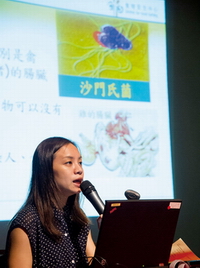
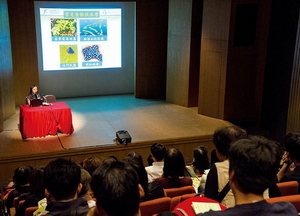
Food Safety Q&A
How To Use Plastic Food Packaging and Containers Safely?

Plastic food packaging and containers bring much convenience to us. However, with growing public concerns over food safety, consumers may be worr ied about the safety of using plastics in food packag ing . In fact, if we understand the properties of different types of plastics and use plastic food packag es and containers properly, plastic food packaging is unlikely to pose a health risk to consumers.
How to identify various types of plastics? What are their properties?
P lastic s that are widely used for the provision of food packaging and containers include polyethylene terephthalate (PET or PETE), high density polyethylene (HDPE), polyvinyl chloride (PVC or V), low density polyethylene (LDPE), polypropylene (PP), polystyrene (PS) and polycarbonate (PC). Each type of plastic s is represented by a number under the plastic identification coding system . The number is featur ed inside a triangle of chasing arrows with the resin abbreviation printed underneath (see table below). The coding system is to identify the plastic material in use to facilitate the recovery and recycling of post-use plastics. It should be noted that the physical properties of p lastics , such as their resistance to heat, acids, alkalis and oils, can vary from one type of plastics to another .
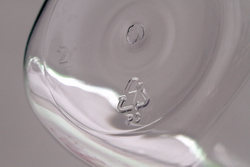
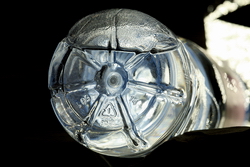
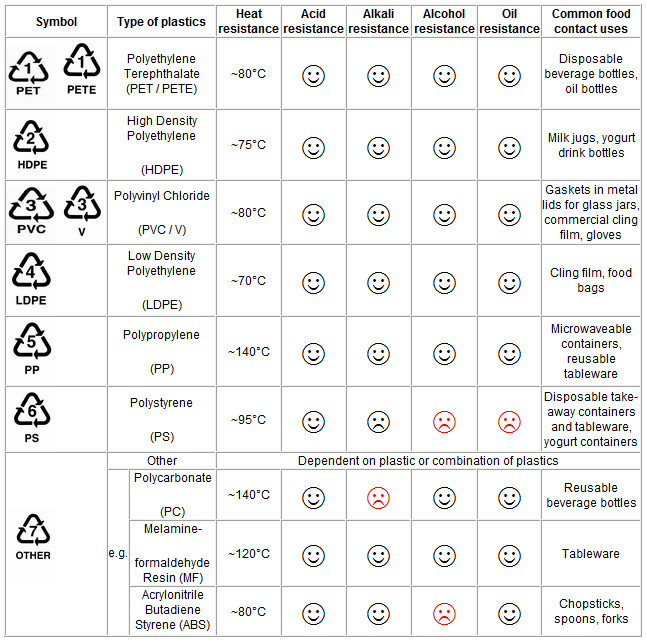
Source of information: The Society of the Plastics Industry, Plastics New Zealand, The Japan Plastics Industry Federation, British Plastics Federation, PlasticsEurope, American Chemistry Council and product specifications provided by manufactures. For food contact articles made of plastic s, their properties may vary from one to another due to differences in their formula and processing methods.
What are the safety issue s of plastic food packaging and containers?
Chemicals like additives used in the manufacture of plastics may migrate into food when plastic food packages and containers are in use. The amount of chemical migration depends on a number of factors, including the nature of the food packaged / contained, and the temperature and period of time during which contact takes place . Nevertheless, p roper usage of plastics will have insignificant chemical migration and will not constitute health hazards to consumers. Other than this, beware that b ottled water and drinks, once opened, will provide a damp or water-filled environment favourable for the growth of bacteria and fungi. Therefore, refilling water or beverage bottles made of plastics can result in contamination of the drinks. Yet with safe handling and proper cleansing of plastic bottles, bacterial growth can be prevented .
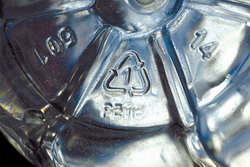
How to use or reuse plastic food packaging and containers properly?
-
Disposable plastic containers
- When choosing disposable plastic containers, take into account the characteristics of the food to be contained (e.g. whether it is fatty, oily or acidic), the food temperature and the duration of contact. Use containers made of good heat - resistan t materials (e.g. polypropylene (PP)) to hold foods over 100°C (e.g. foods just after deep-frying, congee and noodles in soup). Alternatively, let the food cool down for a while before placing it in a plastic container. PP containers are not suitable for holding foods over 120°C, for which high heat-resistant containers (e.g. foil-lined paper boxes) should be used.
- Do not put foods into disposable plastic containers too soon. This can help shorten the time of the container in contact with food and minimise the risk of hazardous chemical migration.
- Microwaveable disposable plastic containers are normally designed for single use . Avoid reusing plastic takeaway containers to hold food for microwave heating .
- Before reusing disposable plastic bottles, check if there are cracks on them and whether they have been thoroughly cleansed and are completely dried. Besides, reuse plastic packaging and containers on a like-to-like basis. For example, if a bottle was originally filled with water, do not resuse them for holding other drinks and beverages.
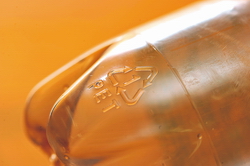
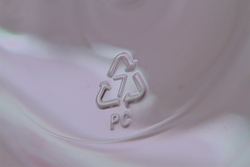
-
Plastic tableware and containers
- Follow the manufacturer's instructions , especially with regard to temperature limitations and their use in microwave ovens and freezers.
- Do not use abrasive detergents , scratchy cleaning tools or strong chemicals that will damage the surface of plastic tableware.
- Avoid storing oily or highly acidic foods in plastic containers over a long period of time.
-
Cling films and food bags
- When heating food in a microwave oven, ensure that the cling film does not touch the food. Do not use cling film and food bags for high-fat foods unless specified as acceptable by the manufacturer. These foods include certain types of cheese, meat with a layer of fat on top, deep-fried foods, pastr ies , cakes and chocolates.
- Do not heat food s stored in takeaway food bags.
Truth against Fallacy
Are A ll Sweeteners Artificial Chemicals?
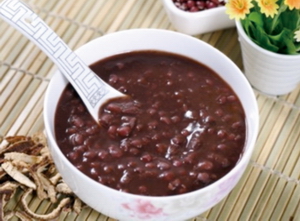
| Ming: |
After a tiring day at work, let's treat ourselves to some desserts after dinner.
|
| Pat : |
Desserts? We are already full from dinner. Besides, desserts are usually high in sugar content. A bowl or a serving size of 390 grams of sweet red bean soup contains about 26 grams of sugar, roughly equivalent to 5 sugar cubes. An individual with a daily intake of 2000 kilocalories energy should not consume more than 50 grams of sugar per day. Having a bowl of sweet red bean soup will exceed the recommended daily sugar intake by more than a half!
|
| Ming: |
I know excessive consumption of sugar may increase the risk of overweight and obe sity. Does it have other adverse effects on health?
|
| Pat : |
A high intake of sugar can also increase the risk of dental caries. T oothache is the wors t pain ever !
|
| Ming: |
But I have a sweet tooth. I know that some foods use sweeteners to substitute sugar. W hat are sweeteners? Are they all artificial chemicals?
|
| Pat : |
According to the laws of Hong Kong, a sweetener means any chemical compound which is sweet to the taste, but does not include any sugars or any carbohydrates or polyhydric alcohols. Presently, there are ten permitted sweeteners. Many people are unfamiliar with sweeteners. Just by looking at their names, they may think that all sweeteners are artificial chemicals. In fact, some sweeteners are natural plant extracts. For instance, steviol glycosides (SGs) are sweeteners obtained from stevia, a native plant of South America. In Brazil and Paraguay, for hundreds of years, stevia leaves have been used to add a sweet taste to tea and food. It was not until the 19 70s that SGs were first commercialised as sweeteners in Japan. SGs are now on the list of permitted sweeteners in Hong Kong.
|
| Ming: |
Great! I can continue to enjoy my favourable desserts as much as I like.
|
| Pat : |
Have y ou forg o tten the principles of healthy eating – balance and variety? We'd better change our dietary habits by cutting down on food with excessive sugars and switching to lighter flavours. Our taste buds can then gradually adapt to less sweety food. The next time we buy prepackaged food s , we can al so read the nutrition labels on the packages and pick low-sugar foods. As for your favourite desserts….
|
| Ming: | Got it! Desserts, only a tidbit. |
Brain Gym
Multiple Choice Questions
Would you like to enjoy your meal with peace of mind? F oodborne diseases can be prevented by following the "5 Keys to Food Safety" advocated by the World Health Organi z ation. Try and s ee if you can identify the "5 keys" from the following :
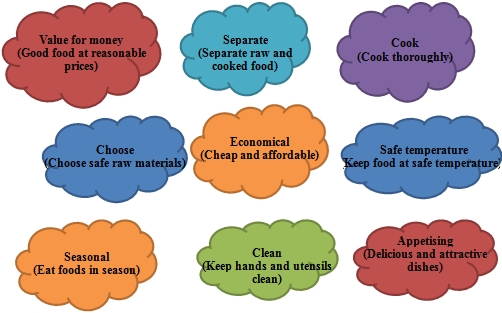
Answers :
Choose
(Choose safe raw materials)
Clean
(Keep hands and utensils clean)
Separate
(Separate raw and cooked food)
Cook
(Cook thoroughly)
Safe temperature
(Keep food at safe temperature)
Enquiries and Subscription
Printed copies of the Food Safety Express can be obtained from the Communication Resource Unit at 8/F., Fa Yuen Street Municipal Services Building, 123A Fa Yuen Street, Mong Kok, Kowloon. For enquiries, please call 2381 6096. The public may also visit the CFS website (www.cfs.gov.hk) for the online version.
| Enquiry hotline | 2868 0000 |
|---|---|
| E-mail address | enquiries@fehd.gov.hk |
| CFS website | www.cfs.gov.hk |
